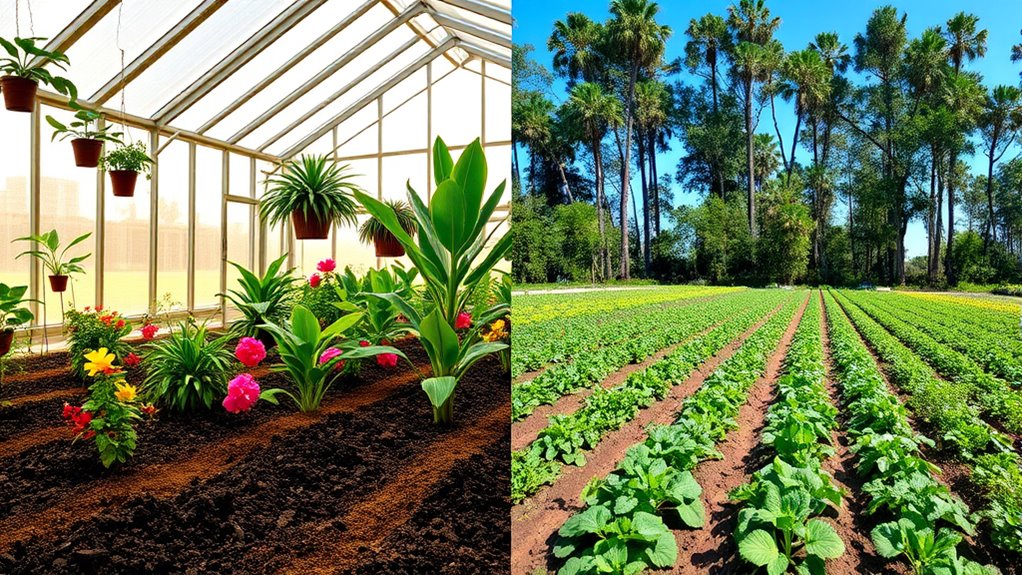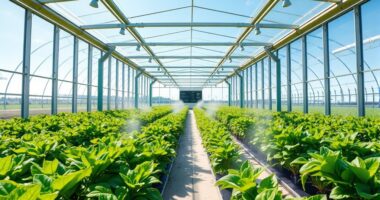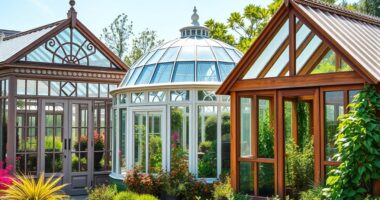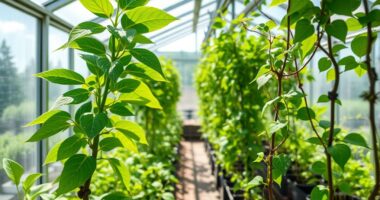Greenhouses provide you with precise control over temperature, humidity, and light, allowing you to extend growing seasons and protect delicate plants from unpredictable weather and pests. Outdoor gardening depends on natural conditions, benefiting from local ecosystems but exposing your plants to weather surprises and less control over pests. Your choice depends on your goals, space, and effort you’re willing to invest—exploring these differences further reveals how to optimize your gardening success.
Key Takeaways
- Greenhouses provide superior climate control, extending growing seasons and protecting plants from weather extremes.
- Outdoor gardening benefits from natural environmental conditions and ecological interactions like pollinators and beneficial insects.
- Greenhouses enable targeted pest management and reduce pesticide reliance through controlled environments.
- Outdoor gardening offers a more natural experience but is more vulnerable to unpredictable weather and pests.
- The choice depends on gardening goals, plant types, available space, and desired level of environmental management.
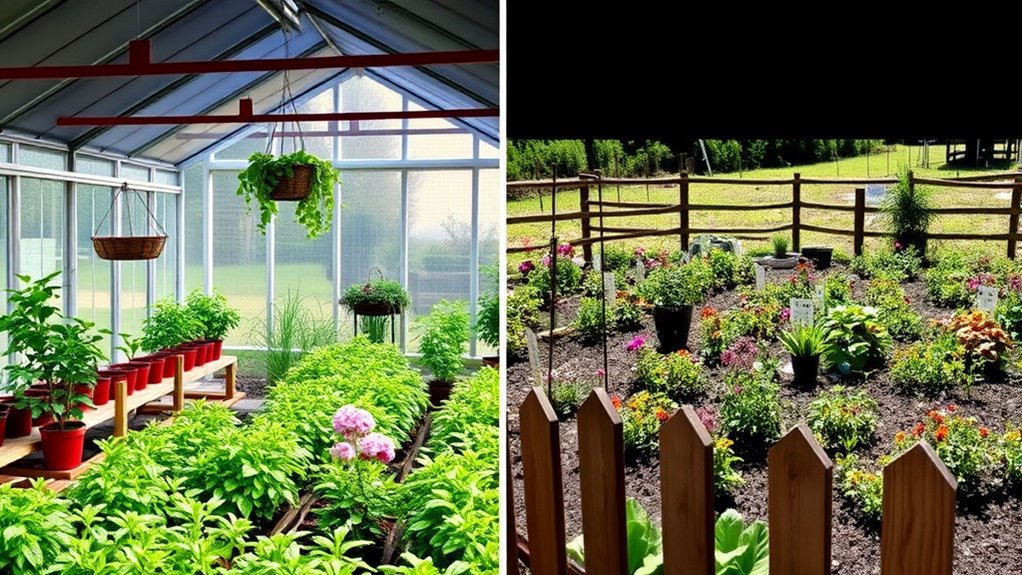
Have you ever wondered whether greenhouse gardening or outdoor gardening is better for your plants? The choice can considerably impact how well your plants grow, how much effort you put into maintaining them, and the overall success of your garden. When comparing the two, one of the biggest advantages of a greenhouse is the ability to manage climate control. Inside a greenhouse, you can regulate temperature, humidity, and light levels, creating an ideal environment regardless of external weather conditions. This means you can extend your growing season, grow delicate plants that might not survive outdoors, and avoid the stress of sudden temperature drops or heatwaves. Climate control also allows you to maintain consistent watering schedules, which helps prevent issues like overwatering or drought stress. Additionally, protective styling benefits of a greenhouse environment help keep plants safe from harsh weather conditions or pests, further promoting healthy growth.
Greenhouses offer climate control to extend growing seasons and protect delicate plants.
Another key benefit of using a greenhouse is pest management. When you have a controlled environment, it’s easier to implement measures that keep pests at bay. You can install screens, use targeted organic sprays, or even introduce beneficial insects without worrying about pests sneaking in from the outdoors. This level of control reduces the need for chemical pesticides, making your gardening safer for both plants and your family. On the other hand, outdoor gardening exposes your plants directly to natural elements, which can be advantageous in some ways. Nature offers natural pest predators, such as birds or beneficial insects, that help keep pest populations in check without intervention. However, outdoor gardens are more vulnerable to unpredictable weather conditions that can damage plants or hinder growth, such as storms, frosts, or excessive rain. You also have less control over climate variables, which can stress plants or limit what you can grow successfully.
In terms of climate control, outdoor gardening relies entirely on your local climate and seasonal changes. While this might be simpler and less costly initially, it means you’re at the mercy of weather patterns, and you might need to adapt your planting schedule accordingly. Pest management outdoors can be more challenging because pests can come from neighboring areas, weeds can harbor insects, and you have fewer options for targeted control. You’ll need to be vigilant, using organic or integrated pest management strategies to minimize damage without harming beneficial insects or the environment.
Ultimately, if you’re seeking more control over environmental factors and want to reduce pest issues, a greenhouse offers considerable advantages. But if you prefer a natural approach, enjoy working with the environment, and don’t mind the extra vigilance, outdoor gardening can be very rewarding. Your choice depends on your gardening goals, available space, and how much effort you want to dedicate to managing climate and pests.
Frequently Asked Questions
How Does Pest Control Differ Between Greenhouse and Outdoor Gardens?
Pest control varies considerably between greenhouses and outdoor gardens. In greenhouses, you can implement targeted pest prevention strategies like biological pest control, which involves introducing natural predators to keep pests at bay. You have more control over environmental factors, making it easier to prevent infestations. Outdoor gardens rely more on organic treatments and physical barriers, as pests are more widespread and harder to manage. Your approach must adapt to each environment’s unique challenges.
What Are the Initial Costs for Setting up a Greenhouse Versus Outdoor Gardening?
Have you wondered about the initial costs for setting up a greenhouse versus outdoor gardening? The cost comparison shows that a greenhouse typically requires a higher investment cost upfront, including materials, heating, and ventilation. Outdoor gardening, on the other hand, generally involves lower initial costs, mainly for tools and soil preparation. Your choice depends on your budget and how much you’re willing to invest in creating an ideal growing environment.
Which Gardening Method Is More Sustainable Long-Term?
You might find outdoor gardening more sustainable long-term because it typically requires fewer resources, reducing environmental impact. With sustainability practices like composting and water conservation, you can lower your footprint. Greenhouses, while providing control, often demand more energy and materials, which can be less eco-friendly over time. So, if your goal is to minimize environmental impact, outdoor gardening generally offers a more sustainable approach.
How Do Weather Changes Impact Greenhouse Versus Outdoor Gardening?
Weather changes are like unpredictable waves, challenging your gardening plans. In a greenhouse, you gain better climate adaptability, controlling temperature and humidity to extend seasonal flexibility. Outdoor gardening, however, depends heavily on natural weather, making it more vulnerable to frost, drought, or excessive rain. You’ll find that a greenhouse offers more stability amid changing weather patterns, ensuring your plants thrive regardless of external fluctuations.
Can I Grow the Same Plants in Both Greenhouse and Outdoor Gardens?
Yes, you can grow many of the same plants in both greenhouse and outdoor gardens. However, consider plant compatibility and soil requirements, as some plants thrive better in controlled greenhouse conditions, while others prefer outdoor environments. Adjust soil amendments accordingly, and choose plants suited for each setting. With proper planning, you can successfully grow a variety of crops in both spaces, maximizing your garden’s productivity and diversity.
Conclusion
Ultimately, choosing between greenhouse and outdoor gardening depends on your goals and climate. Think of a greenhouse as your personal plant sanctuary, offering control and protection, much like a cozy home. Outdoor gardening, on the other hand, is like embracing nature’s unpredictability and beauty. Both methods have unique advantages—greenhouses provide consistent growth conditions, while outdoor gardens connect you directly with the environment. Decide what suits your style, and watch your garden thrive, no matter which path you choose.
